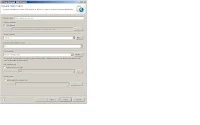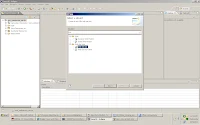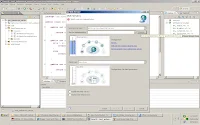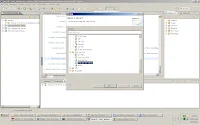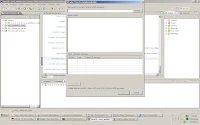This post will describe to work with spring and xslt.
1. open Eclipse and create a dynamic webproject - provide name as spring-xslt(you can give what ever name you want)
2. After that select the target runtime environment(ex: location of tomcat or Jboss or respective server)
3. open web.xml which already created by eclipse for you, modify as mentioned below.
4. After that create simple-servlet.xml like mentioned below and put inside WEB-INF
6. Now Need to create Contoller class by extending AbstractCommandController.
home.(class)=com.siva.HomePage
home.stylesheetLocation=/WEB-INF/xsl/home.xslt
home.root=words
9.finally create one index.html or jsp to submit the form.
<body>
<form action="login.htm" name="login">
Word Id :<input type="text" value="" name="wordId">
Word NAME :<input type="text" value="" name="wordName">
<input type="submit" value="submit">
</form>
</body>
Above mentioned html/jsp is for to submit the form, if we required fileds need to be eneterd by the user then we have to get that values from command object, and then needs to process.
10. Now Everthing is completed. Once you configured and copied the above code into respective places.
We can exceuting the application and can able to see the results.
11. for this project required jars are..
commons-logging-1.1.1.jar
log4j-1.2.15.jar
spring-2.5.6.jar
spring-beans.jar
spring-webmvc.jar
jdom-1.0.jar
1. open Eclipse and create a dynamic webproject - provide name as spring-xslt(you can give what ever name you want)
2. After that select the target runtime environment(ex: location of tomcat or Jboss or respective server)
3. open web.xml which already created by eclipse for you, modify as mentioned below.
<web-app id="WebApp_ID" version="2.4" xmlns:xsi="http://www.w3.org/2001/XMLSchema-instance" xmlns="http://java.sun.com/xml/ns/j2ee" xsi:schemalocation="http://java.sun.com/xml/ns/j2ee http://java.sun.com/xml/ns/j2ee/web-app_2_4.xsd">
<display-name>spring-xslt</display-name>
<welcome-file-list>
<welcome-file>index.html</welcome-file>
</welcome-file-list>
</div>
<servlet>
<servlet-name>simple</servlet-name>
<servlet-class>
org.springframework.web.servlet.DispatcherServlet
</servlet-class>
</servlet>
<servlet-mapping>
<servlet-name>simple</servlet-name>
<url-pattern>*.htm</url-pattern>
</servlet-mapping>
</web-app>
4. After that create simple-servlet.xml like mentioned below and put inside WEB-INF
<?xml version="1.0" encoding="UTF-8"?>
<beans xmlns="http://www.springframework.org/schema/beans"
xmlns:xsi="http://www.w3.org/2001/XMLSchema-instance"
xsi:schemaLocation="http://www.springframework.org/schema/beans
http://www.springframework.org/schema/beans/spring-beans.xsd" >
<bean id="viewResolver" class="org.springframework.web.servlet.view.ResourceBundleViewResolver" >
<property name="order"><value>1</value></property>
<property name="basename" value="views" />
</bean>
<bean id="xsltViewResolver"
class="org.springframework.web.servlet.view.xslt.XsltViewResolver" >
<property name="order"><value>2</value></property>
<property name="viewClass"
value="org.springframework.web.servlet.view.xslt.XsltView" />
<property name="sourceKey" value="obj" />
<property name="suffix" value=".xsl" />
<property name="prefix" value="/WEB-INF/xsl/" />
</bean>
<bean id="simpleUrlMapping"
class="org.springframework.web.servlet.handler.SimpleUrlHandlerMapping" >
<property name="mappings" >
<value>
/login.htm=myxsl
</value>
</property>
</bean>
<bean id="myxsl"
class="com.siva.HomePageController" />
<!--<bean id="myxsl"
class="com.siva.XsltDisplayController" />
--></beans>
5. Now we have to create xslt file under /WEB-INF/xsl/home.xslt and place the below mentioned code<?xml version="1.0" encoding="utf-8"?> <xsl:stylesheet version="1.0" xmlns:xsl="http://www.w3.org/1999/XSL/Transform"> <xsl:output method="html" omit-xml-declaration="yes"/> <xsl:template match="/"> <html> <head><title>Hello!</title></head> <body> <h1>My First Words</h1> <xsl:apply-templates/> </body> </html> </xsl:template> <xsl:template match="word"> <xsl:value-of select="."/><br/> </xsl:template> </xsl:stylesheet>
6. Now Need to create Contoller class by extending AbstractCommandController.
package com.siva;
import java.util.ArrayList;
import java.util.HashMap;
import java.util.List;
import java.util.Map;
import javax.servlet.http.HttpServletRequest;
import javax.servlet.http.HttpServletResponse;
import org.springframework.web.servlet.ModelAndView;
import org.springframework.web.servlet.mvc.AbstractController;
public class HomePageController extends AbstractController{
protected ModelAndView handleRequestInternal(
HttpServletRequest request,
HttpServletResponse response) throws Exception {
Map map = new HashMap();
List wordList = new ArrayList();
wordList.add("hello");
wordList.add("world");
map.put("wordList", wordList);
return new ModelAndView("home", map);
}
}
7. Need to create xslt view class to iterate the xslt elements.package com.siva;
import java.util.Iterator;
import java.util.List;
import java.util.Map;
import javax.servlet.http.HttpServletRequest;
import javax.servlet.http.HttpServletResponse;
import javax.xml.parsers.DocumentBuilderFactory;
import javax.xml.transform.Source;
import javax.xml.transform.dom.DOMSource;
import org.springframework.web.servlet.view.xslt.AbstractXsltView;
import org.w3c.dom.Document;
import org.w3c.dom.Element;
import org.w3c.dom.Text;
public class HomePage extends AbstractXsltView {
protected Source createXsltSource(Map model, String rootName, HttpServletRequest
request, HttpServletResponse response) throws Exception {
Document document = DocumentBuilderFactory.newInstance().newDocumentBuilder().newDocument();
Element root = document.createElement(rootName);
List words = (List) model.get("wordList");
for (Iterator it = words.iterator(); it.hasNext();) {
String nextWord = (String) it.next();
Element wordNode = document.createElement("word");
Text textNode = document.createTextNode(nextWord);
wordNode.appendChild(textNode);
root.appendChild(wordNode);
}
return new DOMSource(root);
}
}
8.Create views.properties file under WEB-INF/classes/views.propertieshome.(class)=com.siva.HomePage
home.stylesheetLocation=/WEB-INF/xsl/home.xslt
home.root=words
9.finally create one index.html or jsp to submit the form.
<body>
<form action="login.htm" name="login">
Word Id :<input type="text" value="" name="wordId">
Word NAME :<input type="text" value="" name="wordName">
<input type="submit" value="submit">
</form>
</body>
Above mentioned html/jsp is for to submit the form, if we required fileds need to be eneterd by the user then we have to get that values from command object, and then needs to process.
10. Now Everthing is completed. Once you configured and copied the above code into respective places.
We can exceuting the application and can able to see the results.
11. for this project required jars are..
commons-logging-1.1.1.jar
log4j-1.2.15.jar
spring-2.5.6.jar
spring-beans.jar
spring-webmvc.jar
jdom-1.0.jar
